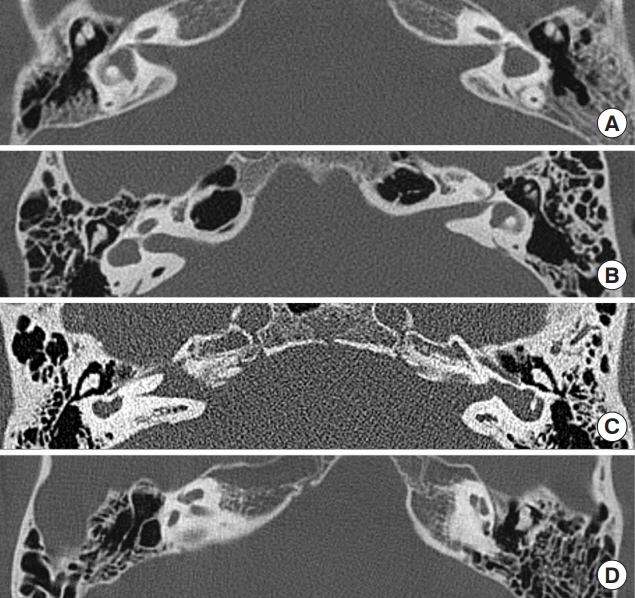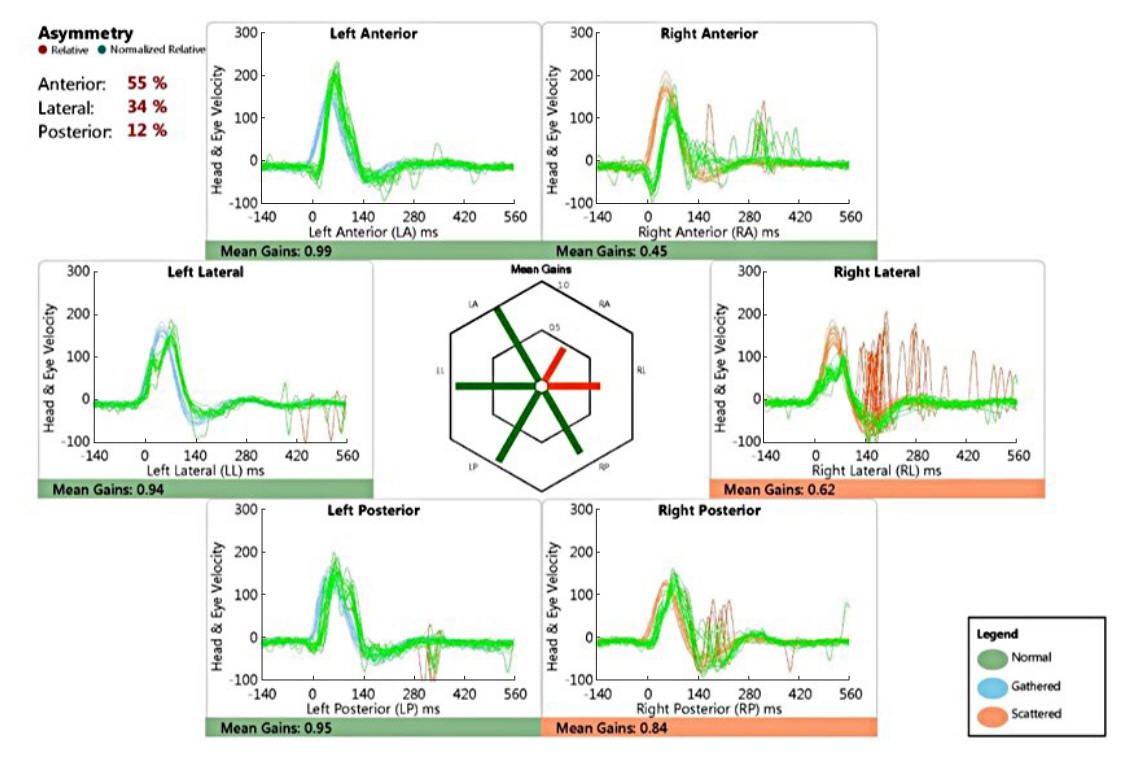Clin Exp Otorhinolaryngol.
2020 Aug;13(3):255-260. 10.21053/ceo.2019.01053.
Audiological and Vestibular Functions in Patients With Lateral Semicircular Canal Dysplasia and Aplasia
- Affiliations
-
- 1Department of Otorhinolaryngology, Yonsei University College of Medicine, Seoul, Korea
- KMID: 2504920
- DOI: http://doi.org/10.21053/ceo.2019.01053
Abstract
Objectives
. The aim of the present study was to evaluate audiologic and vestibular functions in patients with lateral semicircular canal (LSCC) dysplasia/aplasia.
Methods
. We conducted a retrospective study of a patients with LSCC dysplasia and aplasia at tertiary referral center. The subjects included 15 patients with LSCC dysplasia or aplasia, with or without combined inner ear anomalies. Medical history, temporal bone computed tomography scans, pure-tone audiograms, and vestibular function test results were analyzed.
Results
. LSCC anomaly was identified in 15 patients (20 ears). Nine patients had unilateral LSCC dysplasia only and showed a mean pure-tone average of 45.5±28.7 dB, while three patients (33.3%) among them had normal hearing. Six patients had bilateral LSCC dysplasia/aplasia combined with other inner ear anomalies and profound bilateral hearing loss. Notably, only four out of 15 patients (26.7%) had dizziness symptoms. On caloric test, patients with isolated LSCC dysplasia showed a 51.8%±29.3% level of canal paresis (eight out of nine patients showed anomalies), whereas patients with bilateral LSCC dysplasia/aplasia presented bilateral vestibular loss. One patient with isolated LSCC underwent video-head impulse test; horizontal canal gain decreased to 0.62 (17% asymmetry) and anterior canal gain was 0.45 (52.6% asymmetry), whereas posterior canal gain was normal.
Conclusion
. Bilateral LSCC dysplasia/aplasia is comorbid with other inner ear anomalies and presents as profound bilateral hearing loss and vestibulopathy. In contrast, isolated unilateral LSCC dysplasia presents as ipsilateral horizontal canal paresis. Hearing function in isolated LSCC dysplasia is usually, but not always, impaired with varying severity.
Keyword
Figure
Reference
-
1. Korver AM, Smith RJ, Van Camp G, Schleiss MR, Bitner-Glindzicz MA, Lustig LR, et al. Congenital hearing loss. Nat Rev Dis Primers. 2017; Jan. 3:16094.
Article2. Jensen J. Congenital anomalies of the inner ear. Radiol Clin North Am. 1974; Dec. 12(3):473–82.3. Casselman JW, Offeciers EF, De Foer B, Govaerts P, Kuhweide R, Somers T. CT and MR imaging of congential abnormalities of the inner ear and internal auditory canal. Eur J Radiol. 2001; Nov. 40(2):94–104.
Article4. Yu KK, Mukherji S, Carrasco V, Pillsbury HC, Shores CG. Molecular genetic advances in semicircular canal abnormalities and sensorineural hearing loss: a report of 16 cases. Otolaryngol Head Neck Surg. 2003; Dec. 129(6):637–46.
Article5. Sando I, Shibahara Y, Takagi A, Takahara T, Yamaguchi N. Frequency and localization of congenital anomalies of the middle and inner ears: a human temporal bone histopathological study. Int J Pediatr Otorhinolaryngol. 1988; Oct. 16(1):1–22.
Article6. Wineland A, Menezes MD, Shimony JS, Shinawi MS, Hullar TE, Hirose K. Prevalence of semicircular canal hypoplasia in patients with CHARGE syndrome: 3C syndrome. JAMA Otolaryngol Head Neck Surg. 2017; Feb. 143(2):168–77.7. Johnson J, Lalwani AK. Sensorineural and conductive hearing loss associated with lateral semicircular canal malformation. Laryngoscope. 2000; Oct. 110(10 Pt 1):1673–9.
Article8. Suehiro S, Sando I. Congenital anomalies of the inner ear: introducing a new classification of labyrinthine anomalies. Ann Otol Rhinol Laryngol Suppl. 1979; Jul-Aug. 88(4 Pt 3 Suppl 59):1–24.9. Sando I, Takahara T, Ogawa A. Congenital anomalies of the inner ear. Ann Otol Rhinol Laryngol Suppl. 1984; Jul-Aug. 112:110–8.
Article10. Phelps PD. Congenital lesions of the inner ear, demonstrated by tomography. Arch Otolaryngol. 1974; Jul. 100(1):11–8.11. Lim R, Brichta AM. Anatomical and physiological development of the human inner ear. Hear Res. 2016; Aug. 338:9–21.
Article12. O’Rahilly R. The early development of the otic vesicle in staged human embryos. J Embryol Exp Morphol. 1963; Dec. 11:741–55.13. Yamashita K, Yoshiura T, Hiwatashi A, Tuvshinjargal D, Kamano H, Inoguchi T, et al. Sensorineural hearing loss: there is no correlation with isolated dysplasia of the lateral semi-circular canal on temporal bone CT. Acta Radiol. 2011; Mar. 52(2):229–33.
Article14. Yukawa K, Horiguchi S, Suzuki M. Congenital inner ear malformations without sensorineural hearing loss. Auris Nasus Larynx. 2008; Mar. 35(1):121–6.
Article15. Dallan I, Berrettini S, Neri E, Casani AP. Bilateral, isolated, lateral semicircular canal malformation without hearing loss. J Laryngol Otol. 2008; Aug. 122(8):858–60.
Article16. Hadrys T, Braun T, Rinkwitz-Brandt S, Arnold HH, Bober E. Nkx5-1 controls semicircular canal formation in the mouse inner ear. Development. 1998; Jan. 125(1):33–9.
Article17. McGarvie LA, Curthoys IS, MacDougall HG, Halmagyi GM. What does the head impulse test versus caloric dissociation reveal about vestibular dysfunction in Meniere’s disease. Ann N Y Acad Sci. 2015; Apr. 1343:58–62.18. Ozeki M, Kato Z, Sasai H, Kubota K, Funato M, Orii K, et al. Congenital inner ear malformations without sensorineural hearing loss in children. Int J Pediatr Otorhinolaryngol. 2009; Oct. 73(10):1484–7.
Article19. Lopez I, Ishiyama G, Tang Y, Tokita J, Baloh RW, Ishiyama A. Regional estimates of hair cells and supporting cells in the human crista ampullaris. J Neurosci Res. 2005; Nov. 82(3):421–31.
Article
- Full Text Links
- Actions
-
Cited
- CITED
-
- Close
- Share
- Similar articles
-
- Three Cases of Bilateral Semicircular Canal Aplasia with Normal Cochlear Development in the Same Family Member
- A Case of Lateral Semicircular Canal Dysplasia with Normal Cochlea
- A Patient with Sudden Hearing Loss with Vertigo Showing Exclusive Posterior Semicircular Canal Abnormality
- Clinical Characteristics of 7 Patients with Lateral Semicircular Canal Dysplasia
- Expression of Phosphorylated ERK1/2 and cFos Proteins in Vestibular Nuclei by Selective Stimulation of Horizontal Semicircular Canal



